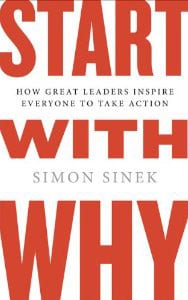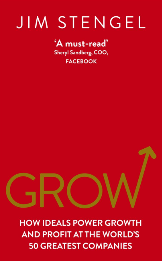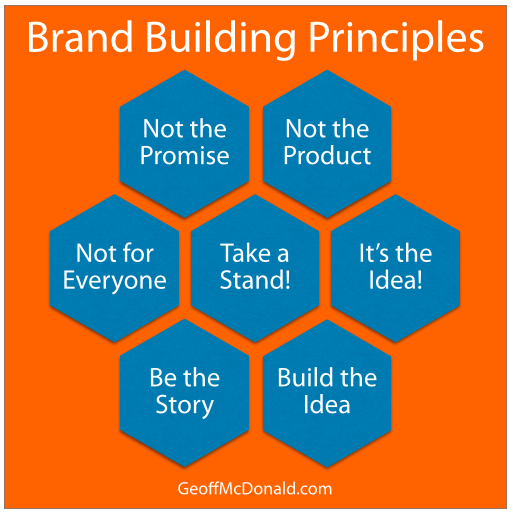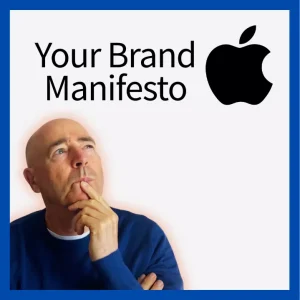Recently, I’ve been approached by a client who has bought the rights to a powerful new product for distribution in Australia and New Zealand. They want me to create a brand new brand for them. That’s right, from scratch!
At the simple level, they require a brand name, a logo and a website. At the bigger level, what they really require is a business strategy, direction and market identity.
As part of my proposal to them I am outlining how I think about brand building and I thought I’d share some of my thoughts with you here. Here are seven brand-building principles…
1 It’s not about the promise
Some brand practitioners talk about the brand promise. Effectively they’re saying ‘When I buy your brand I can count on a particular result’. I think this is really useful and not enough. Whilst this might be emotional, physical or mental, it’s still based on a transaction occurring. And, for me, it smacks of product thinking.
TIP: Being clear what promise you make to your customers is important and it’s not enough to create a powerful brand.
2 It’s not about the products

Simon Sinek in Start With Why tells the classic tale of Dell Computers attempt to sell non-computer items such as an mp3 player. They failed. And, the primary reason given is that customers saw them as a computer company only. In contrast, Apple don’t position, brand or sell themselves as a computer company. Its not even part of their name anymore! And, as a result it was much easier to buy a non-computer from them eg phone, mp3 player, music.
TIP: Your products are short-term investments that will become obsolete at some point whereas your brand will live for as long as your business does.
3 It’s Not for Everyone
If you’ve been reading my blog you’ve probably heard me rabbiting on about Ideas Marketing. That’s my focus for the year and that’s pretty much what I’ll continue to rabbit on about all year.
So, if you’re interested that’s probably good news and if you’re not then too bad. And, this is an important point to make about branding. Your brand is not for everyone.
TIP: To have any credibility your brand cannot be for everyone. I’d go as far as to say that you should create it so some people won’t like it! Without this you’re vanilla, beige and grey. And, worse, you’ll be invisible in the marketplace. No one will notice and no one will care.
[Tweet “Seven principles to build a great brand #branding #ideasmarketing”]
4 Take a Stand!

In his book Grow, Jim Stengel, a former Global Marketing Director for Proctor and Gamble, suggests that we need to aspire to an ideal – a fundamental human value such as: joy, connection or pride. And, he shares the brilliant example of Method who started a movement of “people against dirty”. And, to help you in your fight they provide excellent cleaning products.
TIP: The right order of brand creation is to take a stand first. Then you can build tools and products to forward the fight.
5 It’s all about the idea
One of the drawbacks of traditional marketing and branding is that they tend to live in separate places. As a result, the brand champions are constantly battling with the marketing team and vice versa.
One of my key objectives with the creation of Ideas Marketing was to overcome this artificial separation. Ideas Marketing is really a branding strategy. It’s all about the idea or as Jim Stengel suggested previously, the ideal. Then, the mission is to build the world that brings that ideal to life. In this way, branding and marketing are permanently connected.
TIP: Unite your brand building and marketing into a single strategy and build expressions of your big idea.
[Tweet “The Ideas Marketing approach to brand building #ideasmarketing”]
6 Be the Story
Digital technology and media has overturned a number of long-held beliefs about how to promote, advertise and market products and services.
In his fabulous book True Story, Ty Montague puts forward the view that telling your story no longer works. In other words, the value of advertising and spruiking your message is limited. And, he’s an advertising guy!
Instead, he suggests that we consider Red Bull as a role model in being the story. Rather than simply buying ads or sponsoring fast cars, Red Bull create events that generate enormous public interest. This includes the Red Bull Air Race, Cliff Diving and even Felix Baumgartner’s death defying parachute jump from outer space.
TIP: Telling your story will only get you so far. Instead, you need to be living your story through your actions.
7 Build the Idea
It’s called brand building because that’s what you do – you build the brand so it grows in value. Where I differ from most brand experts is that they seem to be happy to focus on building promotional aspects of the brand eg through advertising taglines, product samples and sponsorships.
My version of things, based on Ideas Marketing, says you literally build the brand instead. You publish about it, you create experiences of it, you build tools and artifacts, you deliberately build a cult or community and you create rituals so your fans can live it everyday.
TIP: Literally build your brand ideal everyday and not as superficial promotional devices. Instead, build real world expressions of your brand so your fans can live it every day.
COMMENT: What is brand building for you? Which points here fit your view and which ones don’t?




